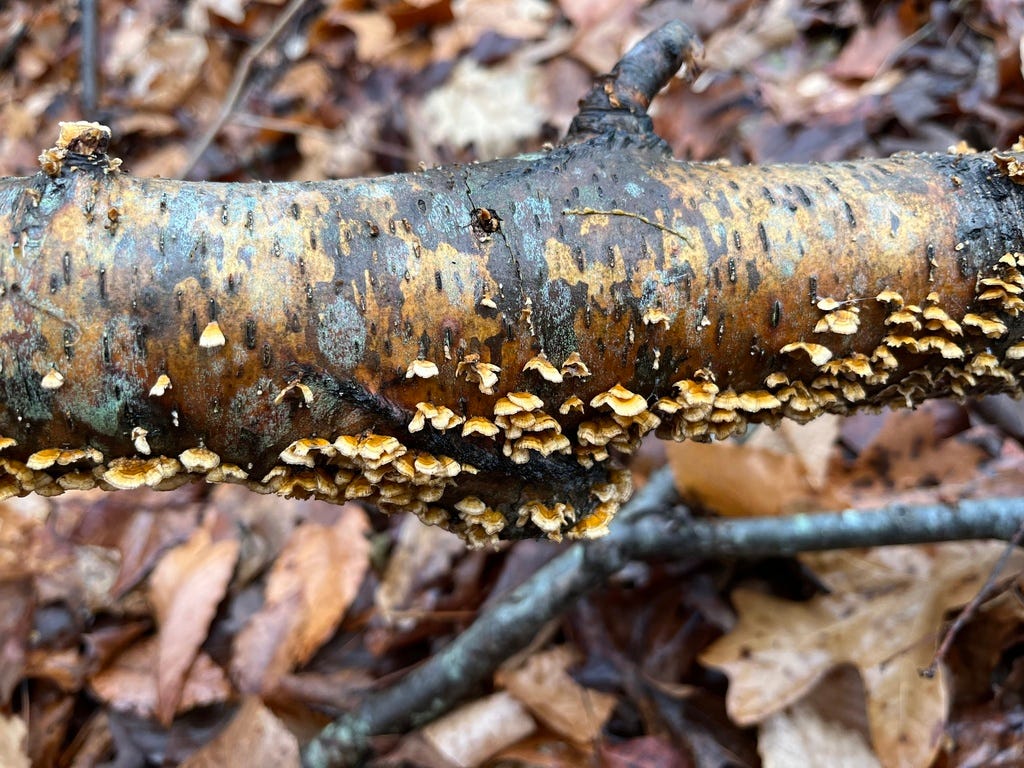Good evening, friends,
This week’s mushroom is known as the Crowded Parchment (Stereum complicatum). This is one of the most common mushrooms you’ll see in the northeast and it looks like a lot of other small, shelf fungi you may confuse it with. Fortunately, there are straightforward ways to distinguish this species from the rest. If it isn’t already in your mushroom ID arsenal already, it certainly will be by the end of the email.

Fun Facts
Interestingly, although S. complicatum is commonly found on hardwood, it has also been found living in turnip leaves where it can wilt the foliage (it seems to be parasitic). This prompted scientists to isolate compounds found in the fungus to see if they could also induce wilt in other plant species (Reference 3). The variety of compounds individually demonstrated some anti-fungal and phytotoxic (poisonous to plants) properties, but none of these effects were considered substantial.
A good deal of fungal research funding, at least until the recent uptick of interest in psilocybin, is focused in agriculture. Probably good in the grand scheme, big picture, prevent a soy or corn rust from crippling the nation and ipso facto the world side of things - but it also leaves a lot of stones unturned.
The name Stereum, from the Greek “stereós”, means “firm” and references the tough texture of those rubbery, overlapping caps seen above. Complicatum means “folded back on itself” which is another appropriate epithet for the way this mushroom grows.
Ecology
S. complicatum is saprobic - it digests and decomposes dead hardwood. I see this most frequently on oak, but it will pop up on any deciduous tree and is usually one of the first mushrooms you’ll seen on recently dead wood. It produces new fruiting bodies spring through fall, but those can persist over winter. The fertile surface likes to grow entirely resupinate on the underside of a branch/log before it then forms the caps just off the sides of the substrate. The fungus is found on either side of the Rockies, but not in them, and in Europe - I suppose it can be found wherever turnips are found too.

There are a variety of Stereum species in the northeast and they’re all common. The way to distinguish Stereum from other polypores is that their underside, the basidial surface if you will, does not have gills nor pores - it is smooth. That feature is indicative of all species of Stereum and will help you tremendously with field identification.
Delving deeper, not many people have a good grasp on which Stereum species are which. S. complicatum has the smallest fruiting body of the bunch but the fungus compensates by producing an overlapping abundance of those crimped shelves.
Sterium fasciatum and Stereum subtomentosum are two others you will see in the area. S. subtomentosum is larger, flatter, and has similar concentric bands of color. S. fasciatum is hairy on top and has subtler colors. S. fasciatum also turns yellow when you wet the underside of the cap (you can use your saliva, even) where as S. subtomentosum does not. As you can see below, sometimes you have an instance where multiple Stereum species appear on the same log and overlap in an area. They’re some of the earliest colonizers and decomposers of dead wood - perhaps because they’re living in the limb before it dies?

Other Spring Fungi
Más morels this past week. These were fruiting by an old apple tree that was already on its last legs before it kicked the can during the drought last summer. These appear to be Morchella Americana. There were four in total and they swelled a bit in size after the weekend rain, but still weren’t much bigger than my palm. I’ll keep checking to see if more appear.
I also found some gilled fungi. That’s right, cap and stipe and all. Below are Deer mushrooms (Pluteus) growing out of a dead stump. Deer mushrooms and Platterful mushrooms are typically the first two species of gilled mushrooms you’ll see in the spring. The Paul Reveres of the forest floor announcing that the gilled mushroom season has begun.
Thankful for the rain and hope you all had a lovely Earth Day,
Aubrey
References:
Kuo, M. (2008, December). Stereum complicatum. Retrieved from the MushroomExpert.Com Web site: http://www.mushroomexpert.com/stereum_complicatum.html
Wilmer H. Perera, et al. "Sesquiterpenoids From Culture of the Fungus Stereum Complicatum (steraceae): Structural Diversity, Antifungal and Phytotoxic Activities." Phytochemistry letters, v. 37 ,. pp. 51-58. doi: 10.1016/j.phytol.2020.03.012
https://www.monaconatureencyclopedia.com/stereum-hirsutum/?lang=en









Didn't know the Greek translation of Stereum, very appropriate especially for S. complicatum!